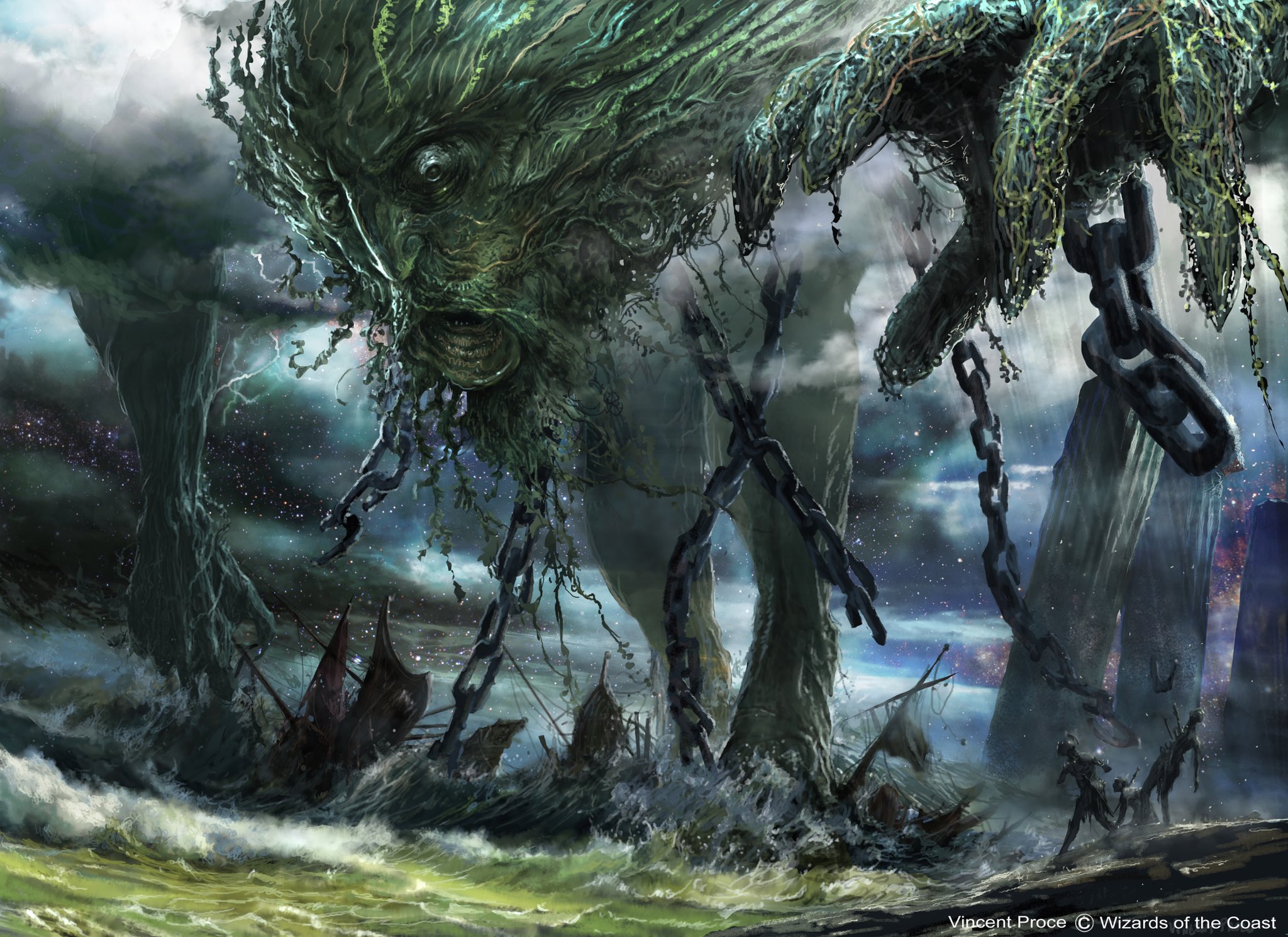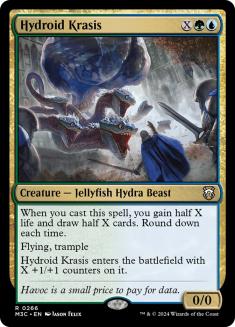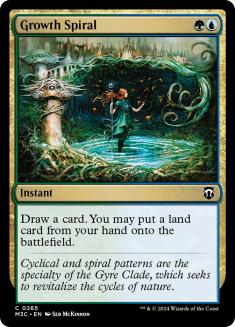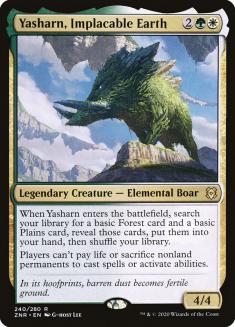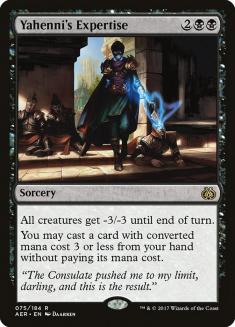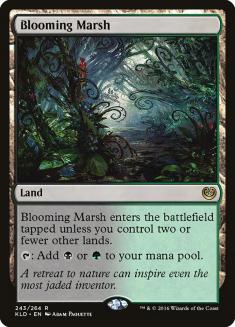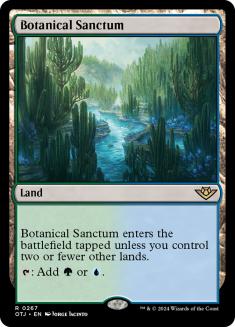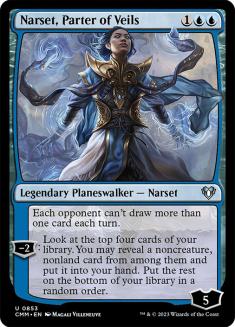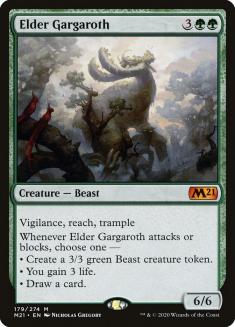Ever since Field of the Dead got banned in Historic, Sultai Midrange has established itself as one of the top decks in the format — it has been one of the top three most popular decks for a long time and I expect it to remain this way unless something radical changes.
The playstyle for Sultai Midrange is fairly standard. Even though it doesn’t have red in it, it’s essentially a Jund deck that’s aiming to trade a bunch of one-for-ones and then ride superior permanents to victory. Having blue instead of red makes you less aggressive, but black offers a lot of cheap removal anyway, and having blue means you’re better at both the late-game and sideboarding. It’s a deck that has almost no bad matchups — it’s usually even-ish or favored across the board against the other most popular decks, and when it’s not favored it’s not by a lot and your games have a lot of play to them.
The reason Sultai Midrange is so popular (and good) is that it’s the deck that best utilizes some of the top cards in the format. Uro, Titan of Nature’s Wrath might be the best card in Historic on individual power level. Thoughtseize is not far behind, and the two cards are just fantastic with each other, as Uro wants one-for-ones early on to fuel it and Thoughtseize wants lifegain and late-game insurance. Other people might be able to play Uro or they might be able to play Thoughtseize, and they will effectively have an “8” in their decks, but Sultai Midrange is the only one that can play both, at which point you’re turning both cards into “10”s.
As such, the core of a Sultai Midrange deck is always going to be Thoughtseize and Uro — hence the Sultai colors. Everything else can change, and have changed throughout Sultai’s time in Historic, but nowadays most lists adopt the Nissa, Who Shakes the World / Hydroid Krasis / Growth Spiral core as well.
I would say that, right now, the most iconic list is probably the one Seth Manfield used to win the Mythic Invitational earlier this year:
Creatures (7)
Planeswalkers (4)
Lands (28)
Spells (21)

The biggest difference between Seth’s list and the other lists at the time was the full four copies of Aether Gust. In a field where the most popular decks were Mono-Red Goblins, Jund Sacrifice, and the mirror, this decision made a ton of sense and Seth was rewarded with a win.
Other than four Aether Gust, though, I’d say the list was fairly standard.
After that, we had the Grand Finals, a tournament with a slightly different metagame but still with a heavy Sultai presence. In that tournament, most builds splashed white for Yasharn, Implacable Earth as a response to the emergence of Jund Sacrifice.
Here’s the list Gabriel Nassif and Raphael Levy took to the Top 8 of the event:
Creatures (9)
Planeswalkers (4)
Lands (28)
Spells (19)

Despite theoretical improvements in the form of Yasharn, Four-Color Midrange didn’t perform as well as it had before due to the emergence of the Four-Color Ramp deck with Omnath, Locus of Creation, which had a very good matchup against it.
Now that Omnath has been banned, the format is ready for Sultai (or Four-Color) again. There are also some interesting tools to be found in Kaladesh Remastered:
Fatal Push is by far the biggest addition to the deck, and it solves the previous question of “Which removal spell do I play?” by just being better than all the alternatives. Previously, there were arguments for Eliminate and for Heartless Act, but Fatal Push is simply more efficient than both of them, and kills almost everything you need to kill. Turning on revolt in this deck isn’t trivial, but you still have Fabled Passage and Uro, Titan of Nature’s Wrath, as well as Hydroid Krasis or Nissa lands dying randomly. The fact that Fatal Push only costs one mana enables you to cast a Turn 3 Uro into Fatal Push, which is a powerful sequence against any creature deck.
Previously, lists were mostly split between Languish and Extinction Event. Here, there’s no clear-cut winner — it really depends on what you expect to face. Against actual creature decks (such as Goblins), Languish is a better card, because these decks have pretty varied costs and it actually kills everything. Against decks with bigger creatures (Azorius Auras) or decks that use the graveyard (Rakdos Arcanist, God-Pharaoh’s Gift, etc.), you’d rather have Extinction Event.
Yahenni’s Expertise isn’t an upgrade to Extinction Event when Extinction Event would be better, but it’s likely an upgrade to Languish. Most creatures have three toughness anyway, and the ability to cast a free Growth Spiral; Uro, Titan of Nature’s Wrath; or Narset, Parter of Veils can be quite valuable. On top of that, if you cast Yasharn, then it’s a creature that survives it. Of course it can backfire if your opponent has managed a four-toughness creature with Auras, or triple lords in Goblins, but I think overall it’s a better Languish, though not by enough that I’d also swap my Extinction Events for it.
Many decks got their manabases upgraded by the fastlands from Kaladesh Remastered, but I don’t think Sultai or Four-Color is one of them (or at least it’s not one where the improvement is meaningful). This deck really wants untapped black mana early on, because of Fatal Push and Thoughtseize, and it also really wants its green sources to be Forests because of Nissa, Who Shakes the World. If you had Darkslick Shores I think this would be a good addition, since it would fit both bills, but you don’t, so I think you’re still stuck with a very similar manabase from before.
The biggest decision I think you have to make with your Sultai deck right now is whether you want Yasharn or not.
This is a hard question to answer because we don’t know what the metagame is going to end up being. Yasharn is obviously great versus decks like Jund Sacrifice, but it’s obviously suboptimal versus decks like the mirror or Goblins.
The card itself is rarely awful — the baseline is a 4/4 for four mana that draws two lands and you often find some random applications for it that you hadn’t really considered before you ran them headfirst into Yasharn and kept clicking on them wondering why they weren’t working, like Skirk Prospector and Treasures from Wily Goblin — but adding a fourth color to your deck for a card that is merely passable is a big cost, even if the card itself isn’t. You must decide on what you think the metagame is going to be. Right now, I lean towards playing Yasharn, but this could honestly change from day to day.
Here’s the decklist that won the SCG Tour Online $5K Kaldheim Championship Qualifier:
Creatures (9)
Planeswalkers (4)
Lands (28)
Spells (19)

I like this list a lot, except it’s playing Languish over Yahenni’s Expertise, which I think is wrong when your deck has 4/4s of its own. Past that, however, I think I agree with every other decision.
I do want to highlight the lack of Shark Typhoon in the maindeck in particular, which I think is quite smart. To me, Hydroid Krasis is basically a better Shark Typhoon Game 1 — you have a lot of mana and you’re not trying to keep any counterspells up, so you gain very little value from it being an instant. Curving Nissa into Shark Typhoon just pales in comparison to curving Nissa into Krasis, so I don’t understand playing Typhoon before you’re maxed out on the alternative.
After sideboarding, things change for two reasons. First, you bring in some counterspells of your own, so you don’t want to tap out all the time. Second, Narset, Parter of Veils becomes a much more prevalent card, so you want both the instant-speed creature to surprise kill it as well as the end-step card drawing. To me, Hydroid Krasis belongs in the maindeck and Shark Typhoon belongs in the sideboard.
If you don’t want to splash white for Yasharn, Implacable Earth, then I think Reid Duke’s list is a reasonable starting point:
Creatures (7)
Planeswalkers (4)
Lands (28)
Spells (21)

Here, we can see that Reid is playing Expertise even though he doesn’t even have a four-toughness creature of his own, which I think is correct. There are some things about this list that I don’t like, though. The first is that I don’t think you can play Botanical Sanctum over Breeding Pool – the ability to untap a land that casts Negate or Aether Gust is too important. The second is that I would rather have some Aether Gusts in the maindeck.
The third is that he’s playing a Shark Typhoon main, and the fourth is that I don’t fully understand some of his sideboard choices, such as Nissa, Vital Force and Ceremonious Rejection. If you want to play straight Sultai, then I would play something like this:
Creatures (7)
Planeswalkers (4)
Lands (28)
Spells (21)

Overall, though, my preference is the four-color version. This is the list I’d play:
Creatures (9)
Planeswalkers (4)
Lands (28)
Spells (19)

The Sideboard
Right now it’s hard to have a strict sideboard guide, because the metagame hasn’t settled yet. I could tell you “this is how I sideboard against Sultai” and then you could play versus a Sultai deck that has over ten different cards, for example. So, I think it’s more useful to explain the function of each sideboard card:
It’s usually pretty obvious when this card is good — you want it versus any deck that it hoses, such as Sacrifice decks or Paradox Engine. It’s rare you’ll want any number of this card in your deck that isn’t zero or three in a sideboarded game; either it’s good enough that you want all of them or you have something better to add.
Narset is quite good in the mirror and versus basically any blue deck.
Pretty much the same as Narset, though you’ll also want them versus any random combo decks (such as Temur Neostorm or Colorless Ramp).
Again, this is for the slower matchups. That’s a lot of cards to sideboard in, but you usually have a lot to take out since whenever these cards come in, the removal comes out.
Versus any aggressive deck, and probably the best of your “bad cards” if you need something to have against someone (such as a deck with absolutely no creatures). Basically if your deck needs to have a bad card in it, then this is the best one (unless Shark Typhoon is not already in, in which case that’s the best one, but usually in the matchups where you run out of things to sideboard in, Shark Typhoon is pretty good).
This is not as necessary when Yasharn already hoses most of the graveyard decks (which is why I don’t have Leyline like in the straight Sultai version), but I still like having access to some, especially if people are trying to Refurbish a God-Pharaoh’s Gift onto the battlefield. It’s also a card you can sideboard in versus aggressive decks like Mono-Red.
For Goblins and aggro decks in general. I think I’d rather have access to the third Expertise over the second Extinction Event, but if you have an extra sweeper then I think that can be an Extinction Event.
Mostly here for Goblins though you’re obviously bringing it in versus the heavy green and red decks.
The Matchups
As a general rule, your matchups are very 50-50-ish, and will depend a lot on what your version looks like — you can build Sultai to be good versus basically anything, though you cannot build it to be good against everything at the same time. This version is built to be better against the Sacrifice decks, and as such suffers a little versus the rest of the field, but it’s still going to be reasonable versus them because you’re still a deck with Thoughtseize, Uro, and Nissa.
The Aura decks are particularly good matchups, since Thoughtseize + Fatal Push + sweepers is extremely good versus them, and decks like Neostorm are pretty good matchups too. Your bad matchups are the decks that go over the top of you, such as Colorless Ramp or God-Pharaoh’s Gift (though this list is better versus those). Basically, if you think of Jund, it’s not so different – you’re good versus creature decks and bad versus “Tron.”
At this point in time I’m still trying other things, since Sultai / Four-Color Midrange is such a known quantity, but I don’t think you can really go wrong with this deck; rather, you can end up playing something that isn’t the best version of Sultai for a given field, but even then it’s not going to be bad. Right now, I think the Yasharn version is best, but this can very reasonably change before the week is over and then you’ll have to adapt the build.

